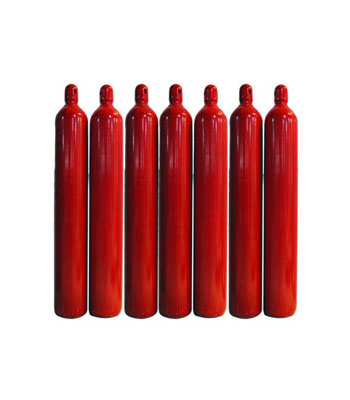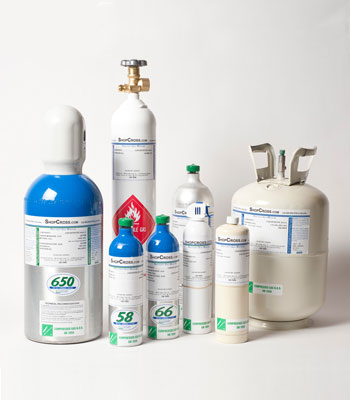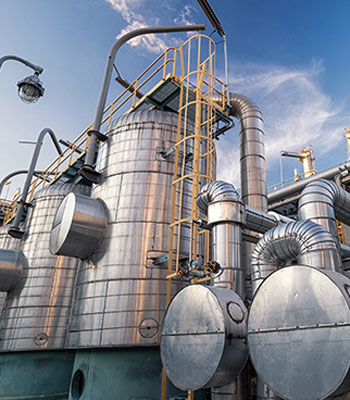Carbon monoxide (CO) Gas
0,00 €Carbon monoxide (CO) gas is formed from the combination of a carbon atom with an oxygen atom. Not only flammable, it is also very hazardous since it is very toxic and odorless. It cannot sustain life and is produced, among other things, from incomplete combustion due to lack of oxygen. It can therefore cause domestic accidents if heating systems are poorly maintained. It is produced on a large scale in industry, in combination with hydrogen, by reforming hydrocarbons, generally natural gas. It is used in large quantities to produce various intermediary organic chemicals, such as acetic acids, isocyanates, formic acid, and also certain polymers such as polycarbonates and polyketones.
Carbon monoxide (CO) Gas
0,00 €Carbon monoxide (CO) gas is formed from the combination of a carbon atom with an oxygen atom. Not only flammable, it is also very hazardous since it is very toxic and odorless. It cannot sustain life and is produced, among other things, from incomplete combustion due to lack of oxygen. It can therefore cause domestic accidents if heating systems are poorly maintained. It is produced on a large scale in industry, in combination with hydrogen, by reforming hydrocarbons, generally natural gas. It is used in large quantities to produce various intermediary organic chemicals, such as acetic acids, isocyanates, formic acid, and also certain polymers such as polycarbonates and polyketones.
Carbon monoxide (CO) Gas
0,00 €Carbon monoxide (CO) gas is formed from the combination of a carbon atom with an oxygen atom. Not only flammable, it is also very hazardous since it is very toxic and odorless. It cannot sustain life and is produced, among other things, from incomplete combustion due to lack of oxygen. It can therefore cause domestic accidents if heating systems are poorly maintained. It is produced on a large scale in industry, in combination with hydrogen, by reforming hydrocarbons, generally natural gas. It is used in large quantities to produce various intermediary organic chemicals, such as acetic acids, isocyanates, formic acid, and also certain polymers such as polycarbonates and polyketones.
Ethylene Gas
0,00 €Ethylene (IUPAC name: Ethene) is a hydrocarbon with the formula C2H4 or H2C=CH2. It is a colorless flammable gas with a faint “sweet and musky” odor when pure. It is the simplest alkene (a hydrocarbon with carbon-carbon double bonds), and the second simplest unsaturated hydrocarbon after acetylene (C2H2). Ethylene is widely used in chemical industry, and its worldwide production (over 109 million tonnes in 2006) exceeds that of any other organic compound. Ethylene is also an important natural plant hormone, used in agriculture to force the ripening of fruits Global ethylene production was 107 million tonnes in 2005 … .
Ethylene Gas
0,00 €Ethylene (IUPAC name: Ethene) is a hydrocarbon with the formula C2H4 or H2C=CH2. It is a colorless flammable gas with a faint “sweet and musky” odor when pure. It is the simplest alkene (a hydrocarbon with carbon-carbon double bonds), and the second simplest unsaturated hydrocarbon after acetylene (C2H2). Ethylene is widely used in chemical industry, and its worldwide production (over 109 million tonnes in 2006) exceeds that of any other organic compound. Ethylene is also an important natural plant hormone, used in agriculture to force the ripening of fruits Global ethylene production was 107 million tonnes in 2005 … .
Ethylene Gas
0,00 €Ethylene (IUPAC name: Ethene) is a hydrocarbon with the formula C2H4 or H2C=CH2. It is a colorless flammable gas with a faint “sweet and musky” odor when pure. It is the simplest alkene (a hydrocarbon with carbon-carbon double bonds), and the second simplest unsaturated hydrocarbon after acetylene (C2H2). Ethylene is widely used in chemical industry, and its worldwide production (over 109 million tonnes in 2006) exceeds that of any other organic compound. Ethylene is also an important natural plant hormone, used in agriculture to force the ripening of fruits Global ethylene production was 107 million tonnes in 2005 … .
Hydrogen sulfide Gas
0,00 €Hydrogen sulfide is the chemical compound with the formula H2S. It is a colorless gas with the characteristic foul odor of rotten eggs; it is heavier than air, very poisonous, corrosive, flammable, and explosive.
Hydrogen sulfide Gas
0,00 €Hydrogen sulfide is the chemical compound with the formula H2S. It is a colorless gas with the characteristic foul odor of rotten eggs; it is heavier than air, very poisonous, corrosive, flammable, and explosive.
Hydrogen sulfide Gas
0,00 €Hydrogen sulfide is the chemical compound with the formula H2S. It is a colorless gas with the characteristic foul odor of rotten eggs; it is heavier than air, very poisonous, corrosive, flammable, and explosive.
Nitrous oxide Gas
0,00 €- Nitrous oxide, commonly known as laughing gas, nitrous, nitro, or NOS is a chemical compound with the formula N2O. It is an oxide of nitrogen. At room temperature, it is a colourless, non-flammable gas, with a slightly sweet odour and taste. It is used in surgery and dentistry for its anaesthetic and analgesic effects. It is known as “laughing gas” due to the euphoric effects of inhaling it, a property that has led to its recreational use as a dissociative anaesthetic. It is also used as an oxidizer in the launching of rockets (= rocketry) and in motor racing to increase the power output of engines. At elevated temperatures, nitrous oxide is a powerful oxidizer similar to molecular oxygen.
- Nitrous oxide gives rise to NO (nitric oxide) on reaction with oxygen atoms, and this NO in turn reacts with ozone. As a result, it is the main naturally occurring regulator of stratospheric ozone. It is also a major greenhouse gas and air pollutant. Considered over a 100-year period, it has 298 times more impact per unit mass (global warming potential) than carbon dioxide.
- It is on the World Health Organization’s List of Essential Medicines, a list of the most important medications needed in a health system.
Nitrous oxide Gas
0,00 €- Nitrous oxide, commonly known as laughing gas, nitrous, nitro, or NOS is a chemical compound with the formula N2O. It is an oxide of nitrogen. At room temperature, it is a colourless, non-flammable gas, with a slightly sweet odour and taste. It is used in surgery and dentistry for its anaesthetic and analgesic effects. It is known as “laughing gas” due to the euphoric effects of inhaling it, a property that has led to its recreational use as a dissociative anaesthetic. It is also used as an oxidizer in the launching of rockets (= rocketry) and in motor racing to increase the power output of engines. At elevated temperatures, nitrous oxide is a powerful oxidizer similar to molecular oxygen.
- Nitrous oxide gives rise to NO (nitric oxide) on reaction with oxygen atoms, and this NO in turn reacts with ozone. As a result, it is the main naturally occurring regulator of stratospheric ozone. It is also a major greenhouse gas and air pollutant. Considered over a 100-year period, it has 298 times more impact per unit mass (global warming potential) than carbon dioxide.
- It is on the World Health Organization’s List of Essential Medicines, a list of the most important medications needed in a health system.
Nitrous oxide Gas
0,00 €- Nitrous oxide, commonly known as laughing gas, nitrous, nitro, or NOS is a chemical compound with the formula N2O. It is an oxide of nitrogen. At room temperature, it is a colourless, non-flammable gas, with a slightly sweet odour and taste. It is used in surgery and dentistry for its anaesthetic and analgesic effects. It is known as “laughing gas” due to the euphoric effects of inhaling it, a property that has led to its recreational use as a dissociative anaesthetic. It is also used as an oxidizer in the launching of rockets (= rocketry) and in motor racing to increase the power output of engines. At elevated temperatures, nitrous oxide is a powerful oxidizer similar to molecular oxygen.
- Nitrous oxide gives rise to NO (nitric oxide) on reaction with oxygen atoms, and this NO in turn reacts with ozone. As a result, it is the main naturally occurring regulator of stratospheric ozone. It is also a major greenhouse gas and air pollutant. Considered over a 100-year period, it has 298 times more impact per unit mass (global warming potential) than carbon dioxide.
- It is on the World Health Organization’s List of Essential Medicines, a list of the most important medications needed in a health system.










